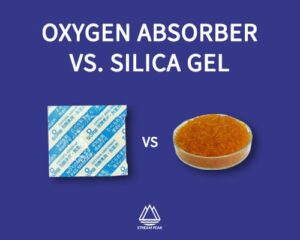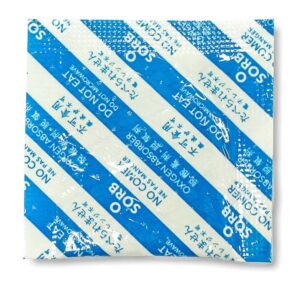
Oxygen Absorber vs Silica Gel
Find out more about the difference between Oxygen Absorbers and Silica Gel. A common question is frequently asked, especially from the food industry, for bulk packing food items for long-term storage. There has been confusion between oxygen absorbers with the small packets found in the new shoe boxes and purses saying “do not eat.”
We will discuss Oxygen Absorbers and Silica Gel more and what characteristics make them different.
Oxygen Absorbers
Oxygen Absorbers, also known as oxygen scavengers, are mini sachets containing iron fillings, clay, and salt. The clay element produces moisture, and the combination of salt will activate the iron fillings to absorb oxygen. This process begins as soon as the Oxygen Absorber packet is exposed. After exposure, the iron fillings start to oxidise straightaway, forming rust and releasing nitrogen. It is this nitrogen that helps in keeping food fresher for a more extended period. The lack of oxygen in the packaging will help keep weevils and insects from infesting the food item.
Some other characteristics of Oxygen Absorbers are:
- Salt and sugar do not need oxygen for long-term storage as both of them will turn rock solid
- Once the packaging is exposed, take out what is required and store the rest in an airtight jar
- Keep the exposure of the oxygen absorbers to the minimum; otherwise, frequent exposure will get them all activated
- For oxygen scavengers to be effective, use the right amount of oxygen scavengers for the food packaging
Oxygen Absorbers come in various sizes and determine how much quantity is required in the container for preservation and storage—oxygen absorbers are measured by cc. Osorb Absorbers come in several types, from 20 cc to 500 cc. For a five to six-gallon of storage bucket, the recommendation would be to use two 500 cc oxygen absorber agents.
Oxygen absorbers are commonly used for foods prone to rancidification, such as nuts and snacks, whole-fat dry foods, processed, smoked, and cured meats, dairy products, spices and seasoning, and flour products. They are also used for other types of food, such as fresh and precooked noodles, pet food, pastries, candies and confectioneries, coffee, tea, dried fruits, and vegetables.
Common Mistakes When Using Oxygen Absorbers
Oxygen absorbers begin working as soon as they are opened, and a common mistake is that users open the packet too soon, failing to place them in a sealed container quickly. This is a problem as the packets will absorb air and will not have much iron left to preserve your food.
Another mistake is that users try to use the ones that no longer work. So how can you tell? Most Oxygen Scavengers contain a little pink pill that changes colour and turns blue if the Oxygen Scavenger has expired or is no longer useful. Another method of checking is to hold the packet in your hand. If you can feel the loose powder, it’s ready to use. If it’s hard or solid, it usually means the contents have been used up and should be discarded.
It is also helpful to store extra absorbers carefully. The better you preserve them, the less frequently you need to buy replacements. In addition, it is also environmentally friendly.
Advantages of Oxygen Absorbers
Oxygen Absorbers are non-toxic, safe to use, and FDA-approved. Use Oxygen Absorbers in food packages to prevent colour change and infestation. They help maintain food quality by delaying discolouration and darkening fruits and some vegetables. They also help maintain the quality of polyunsaturated fats and oils and prevent them from going rancid. Oxygen Absorbers effectively reduce the aerobic environment down to 0.01 per cent oxygen by absorbing most of the oxygen in the packaging. This inhibits the growth of microorganisms or fungi in food products such as dairy, pastries, nuts, and fish. Oxygen absorbers also help extend the shelf-life of pharmaceutical products and minimize the need for some preservatives.
Disadvantages of Oxygen Absorbers
Oxygen absorbers can only be used on dry foods and low-oil content foods. Oxygen absorbers must be used for products that contain 10% moisture or less; otherwise, they can present chances of botulism poisoning. Additionally, oxygen absorbers can only remove a small amount of oxygen from each piece of packaging. They are also single-use and cannot be reused.
Silica Gel
Silica Gel is essentially a composition of silicon dioxide or porous sand. It reduces condensation and allows stored items to remain dry even during extremely damp and humid conditions. The most common use of Silica Gel is often found in packaging bags, vitamins, shoes, and other computer equipment. Silica Gel’s ability to inhibit moisture gives it a unique characteristic to prevent mould growth in the packaging. An example advised would be to use 10 grams of desiccants for a five-gallon basket-size packaging for storage. Use the desiccant to pack dried food items to retain their crispness and hardness. They are also useful to store food items such as fish, meats, poultry, vegetables and fruits, blankets and sheets, and absorbent pads.
Some of the other items where Silica Gel can come in handy for packaging are:
- Camera and video equipment
- Photos
- Gun cases and ammunition cans
- Non-prescription and prescription medicines
- Toolboxes
- Seed packets
- Important documents
- Luggage, etc
Unlike Oxygen Scavengers, Silica Gel is reusable. To reactivate the Silica Gel, spread the saturated Silica Gel beads thinly on a baking sheet and bake for 15 minutes at 79.4°C in a preheated oven. The heat from the oven will absorb moisture from the Desiccant pack, which will aid in the reactivation of the Silica Gel. Please place the Desiccant bag in a zip lock bag after removing it from the oven to keep moisture at bay, and the Desiccant pack will be ready for use when needed. Some interesting ways to reuse silica gel include preventing rust on razor blades, preventing car windscreens from steaming, and preventing seeds from early sprouting.
Advantages of Silica Gel
On its own, Silica Gel is not flammable, non-toxic, and chemically unreactive. The absorbers are commonly packed with dry food packaging to absorb humidity that may spoil the food. Reuse the Silica Gel by heating to stave off any prior absorption. The desiccant can be used for conventional packing and is available in various sizes for different applications. Silica Gel can absorb approximately 40% of humidity or oxygen of its weight. The shelf life of Silica Gel is indefinite if stored in the right conditions. It is also helpful in eliminating odour.
Disadvantages of Silica Gel
Dust from silica gel beads may cause irritation and redness when in contact with the skin and eyes. Additionally, inhaling may cause lung irritation. Silica gel is non-toxic but can be a choking hazard for children if mistakenly consumed.
Using Silica Gel and Oxygen Absorber Together
It is advisable not to use both Silica Gel and Oxygen Absorber together. The reason is the conflict in their nature because Oxygen Absorbers will require moisture to activate and work. On the other hand, Silica Gel exists solely to absorb moisture, which means it will render the Oxygen Absorber useless by halting the activation process due to a lack of oxygen.
Conclusion
So how do you know which is appropriate for your product? Oxygen Scavengers only absorb oxygen, not moisture or air, but Silica Gel absorbs moisture. Therefore, to maintain the humidity level in the packaging, it is recommended to use an Oxygen Scavenger. It will ensure extended freshness with the proper packaging. On the other hand, to enhance the life span of food products, Silica Gel helps reduce the humidity level in the food or other packaging, prolonging shelf life.
Watch this video to learn more about the differences between Oxygen Absorbers VS Silica Gel!


